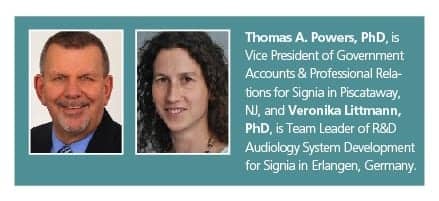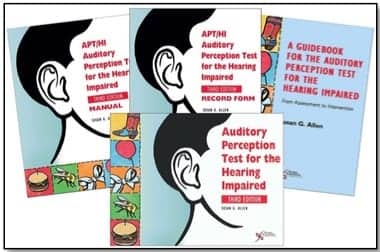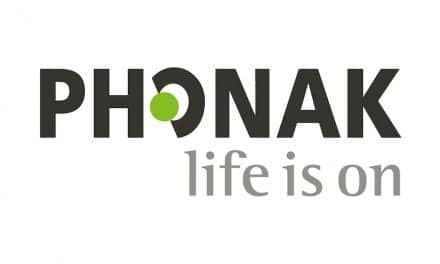Tech Topic | May 2016 Hearing Review
New research shows it is reasonable to expect the same speech recognition benefit for individuals with severe hearing impairment when using binax beamforming technology as previously reported for those with mild-to-moderate losses.
Historically, one of the most effective methods to improve speech understanding in background noise has been the use of directional technology. In recent years, through the use of wireless full-audio transmission between a bilateral pair of hearing aids, binaural beamforming technology has taken the benefit of directional technology to a new level.1,2 Clinical trials with these new products have shown a substantial benefit over omnidirectional, and in fact two independent studies have shown that hearing-impaired individuals fitted with these instruments experience significantly better speech recognition in background noise than their normal-hearing counterparts.3,4
In general, the research with these beamforming instruments has focused on hearing-impaired individuals with mild-to-moderate hearing losses, as this is the audiometric profile of the most common hearing aid user. However, a significant minority of people who use hearing aids have a severe impairment. Can we expect the same speech recognition benefit for these hearing aid users?
When fitting hearing aids to individuals with mild-to-moderate hearing impairment, the primary goal is to restore the lost audibility due to their outer hair cell damage. However, when a severe hearing loss is present, we expect that there will also be inner hair cell damage. This is associated with broadened auditory filters causing loss of frequency selectivity, reducing the ability to separate two signals in the frequency domain. Broad filters allow more noise to pass, which then makes it even more difficult to detect the desired target speech in a competing background noise environment. Moreover, when signals are made audible, there may be a greater susceptibility to distortions.5
A related issue when fitting individuals with severe hearing losses is the consideration of “effective audibility.” As reviewed by Ching et al,6 when hearing loss becomes more severe, the ability of the ear to extract useful information from the signal is reduced, and there comes a point where more audibility will not provide more benefit, and in fact may even be detrimental, particularly if cochlear dead regions are present. Therefore, the amplified signal must be audible, but effective, which can be a small residual dynamic range window for many patients with severe hearing loss.
Simply said, there are many more factors present that can negatively impact the benefit obtained from hearing aids for the severe hearing loss patient than for those with mild-to-moderate losses. Limited research in this area suggests that people with severe losses will obtain at least some additional benefit when fitted with directional technology,7 although this has not been studied with modern beamforming processing. Therefore, the current study was designed to determine if the large benefit obtained in previous research for individuals with mild-to-moderate losses using binaural beamforming technology would also be present when the participants had severe hearing impairments.
Study Design
Participants. The participants (n=18) all had severe symmetrical sensorineural hearing losses (Figure 1). They ranged in age from 61 to 78, with a mean age of 70.3.
Hearing Aids. Binaural beamforming was introduced in the Siemens binax™ instruments (termed Narrow Directionality) and is now available in the Signia primax™ instruments as part of the SpeechMaster function. Pure® binax mini-BTE receiver-in-the-canal (RIC) instruments were used in this study. The gain and output of the hearing aids were programmed for each individual based on their hearing thresholds and according to the proprietary fitting algorithm. For experimental testing, the hearing aids were programmed to three different directional algorithms: mild directional (omnidirectional with pinna effects), traditional adaptive directional, or frontal beamforming (termed “SpeechMaster Direction” in the primax fitting software). All other special features, such as digital noise reduction and feedback suppression, were activated and set to the manufacturer’s default settings. The hearing aids were coupled to the ear using standard double-dome RIC fitting tips.
Speech Material. The speech material used was the sentences of the English version of the Oldenburger Satztest, commonly referred to as the OLSA. All sentences in this material follow the structure: subject-verb-number-adjective-object, (eg, “Robert buys five red flowers”). The background competing signal was also the OLSA sentences, presented uncorrelated from seven different loudspeakers surrounding the listener, with the gaps between sentences removed. That is, while the target OLSA sentence was presented, the listener would also be presented seven other, different OLSA sentences. Additionally, a speech babble was added to the competing material, presented at a level 15 dB below the sentences.
Procedures. Testing was conducted in a standard audiometric test suite at the Vanderbilt University Dan Maddox Hearing Aid Research Laboratory. The array for the presentation of the target and competing speech material consisted of eight loudspeakers surrounding the participant, equally spaced at 45° increments, starting at 0° (ie, 45°, 90°, 135°, etc). The participant was seated 1 meter from all loudspeakers in the center of the room, directly facing the speaker at 0°, which was used to present the target sentences. The competing signals were presented from the seven other loudspeakers. The competing signals were calibrated for equal 68 dBA at the position of the participant when all seven loudspeakers were activated. This signal remained constant at this level for all testing.
Following a practice list, one list of 20 sentences of the OLSA was administered and scored. The testing was automated and adaptive, and the step-size was reduced automatically as testing progressed; the threshold in noise signal-to-noise ratio (SNR) was automatically calculated. The three different microphone conditions were counterbalanced among participants.
Results and Discussion

Figure 2. Displayed are the mean SRT-In-Noise findings and error bars (English OLSA) for three different microphone conditions: Mild Directional (omnidirectional with pinna compensation), Adaptive Directional, and Beamforming.
The speech recognition findings (mean OLSA SRTs-in-noise) for the three different types of processing are shown in Figure 2. This demonstrates a systematic improvement in the speech recognition as the sophistication of the directional processing increases. The adaptive directional was approximately 3 dB better than mild directional (omnidirectional with pinna compensation), and the binaural beamforming processing added another 2 dB to the adaptive directional benefit.
Statistical analysis was completed using a generalized linear model for the three microphone settings. Results revealed a significant main effect of microphone setting (F = 30.885, p < 0.001). There were no other significant main effects or interactions. Linear contrast follow-up evaluation of the significant main effect was completed with Bonferroni adjustment. This analysis revealed that speech recognition performance was significantly different for all three microphone settings. Specifically, mild directional was significantly poorer than adaptive directional (p < 0.003) and beamforming (p < 0.001), and the beamforming performance was significantly better than adaptive directional (p < 0.001).
While these findings show substantial and significant benefit for the beamforming technology, it is meaningful to compare the benefit observed for this severe hearing loss group to that obtained in previous research with individuals with mild-to-moderate hearing loss. As reported by Froehlich et al4 in the earlier research using the same experimental design, the benefit of beamforming, compared to mild directional, was an identical 5.0 dB for both test sites (using the German OLSA and the English HINT material). In the present research (as shown in Figure 2), the mild directional SRT-in-noise was -3.0 dB, and mean performance for the beamforming technology was -7.9 dB—a 4.9 dB advantage.
Our research therefore shows that, when using the binax beamforming technology, it is reasonable to expect the same speech recognition benefit for individuals with severe hearing impairment as we have previously reported for those with mild-to-moderate losses. It is encouraging to observe that this speech recognition benefit is available for those who, due to the physiology of their hearing loss, are the most likely to have greater difficulty understanding speech in difficult listening situations.
References
-
Kamkar-Parsi H, Fischer E, Aubreville M. New binaural strategies for enhanced hearing. Hearing Review. 2014;21(10):42-45. Available at: https://hearingreview.com/2014/10/new-binaural-strategies-enhanced-hearing
-
Herbig R, Froehlich M. Binaural beamforming: The natural evolution. Hearing Review. 2015; 22(5):24. Available at: https://hearingreview.com/2015/04/binaural-beamforming-natural-evolution
-
Powers TA, Fröhlich M. Clinical results with a new wireless binaural directional hearing system. Hearing Review. 2014;21(11):32-34. Available at: https://hearingreview.com/2014/10/clinical-results-new-wireless-binaural-directional-hearing-system
-
Froehlich M, Freels K, Powers T. Speech recognition benefit obtained from binaural beamforming hearing aids: comparison to omnidirectional and individuals with normal hearing. May 28, 2015. Available at: http://www.audiologyonline.com/articles/speech-recognition-benefit-obtained-from-14338
-
Souza PE, Jenstad L, Folino R. Using multichannel wide-dynamic range compression in severely hearing-impaired listeners: Effects on speech recognition and quality. Ear Hear.? 2005;26(2):120-131.
-
Ching TYC, Dillon H, Katsch R, Byrne D: Maximizing effective audibility in hearing aid fitting. Ear Hear. 2001;22(3):212-224.
-
Ricketts TA, Hornsby BW. (2006). Directional hearing aid benefit in listeners with severe hearing loss. Int J Audiol. 2006 Mar;45(3):190-197.
Correspondence can be addressed to HR or Dr Powers at: [email protected]
Original citation for this article: Powers T, Littmann V. Benefits of Binaural Beamforming for Individuals with Severe Hearing Loss. Hearing Review. 2016;23(5):28.?







